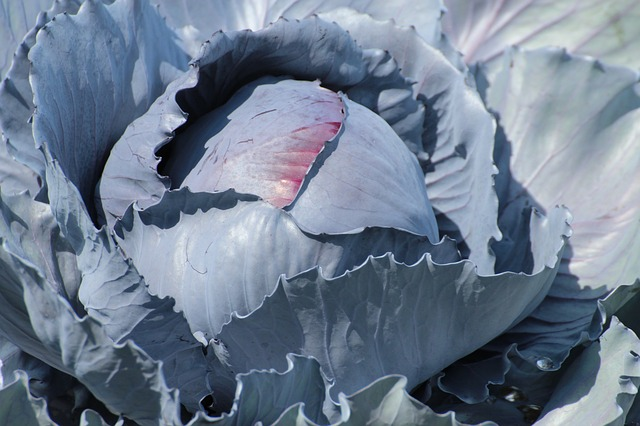
Planting, Growing & Harvesting Red Cabbage: Tips for a Successful Harvest
Red cabbage is a popular winter vegetable that is used cooked or raw in many dishes. The purple head impresses with its sweet, mild cabbage flavor and also contains lots of vitamins and minerals. Here you can find out how to grow this cabbage in your own garden and what you need to bear in mind.
This Article Contains:
- Growing Red Cabbage: What You Need to Know
- The Right Location
- Red Cabbage in a Mixed Culture: Companion Plants
- Mixed Crop Planting Plans With Red Cabbage: Examples & Ideas
- Finding the Right Type of Red Cabbage
- Planting and Sowing Red Cabbage: In the Garden, Raised Bed or Pot
- Proper Care and Fertilization of Red Cabbage
- Preventing Diseases and Pests
- Harvest Time: Harvesting and Storing Red Cabbage
- Processing & Preserving Red Cabbage
- Frequently Asked Questions About Planting Red Cabbage
Quick Overview
Growing Red Cabbage at a Glance:
- Light requirement sunny to semi-shady
- Nutrient requirement high
- Water requirement high
- Soil loose, deep and humus-rich
- Germination temperature 16 - 20 °C/60 - 68 °F
- Sowing: Advance sowing from February / direct sowing from April
- Planting depth 1 cm/0.4 in
- Planting distance 50 x 50 cm/19.7 x 19.7 in
- companion plants/ succession cropping:
- companion plants: lettuce, strawberries, herbs, celery
- no cabbage as a previous crop or as a companion
Growing Red Cabbage: What You Need to Know
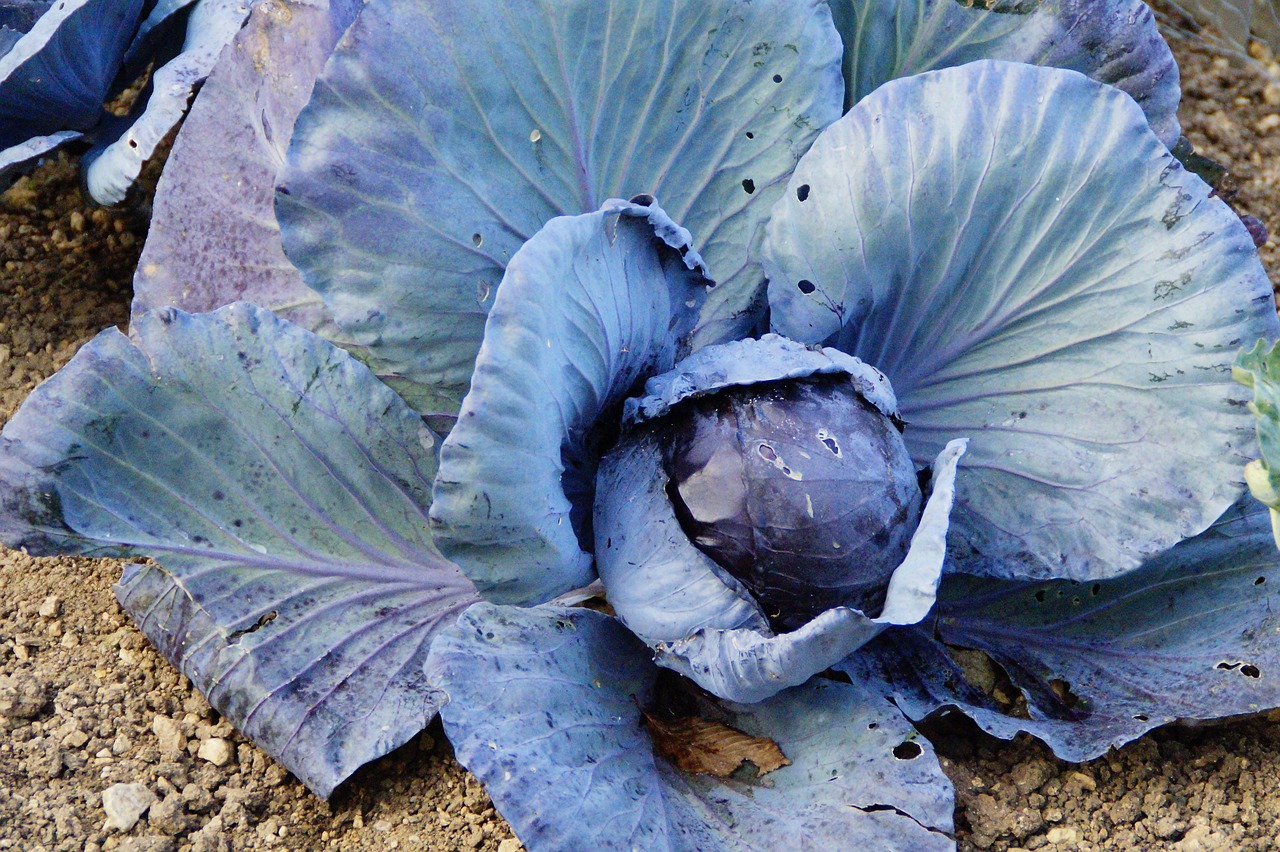
Red cabbage (Brassica oleracea convar. capitata var. rubra) belongs to the cruciferous family (Brassicaceae). You can find An Overview of the Most Popular Cabbages for Growing in the Garden in this article. Head cabbage is also popularly known as red cabbage or blue cabbage. Red cabbage was first mentioned in the 12th century by Hildegard von Bingen, who called it "rubaceae caules". Even then, it was cultivated as a popular winter vegetable as it is easy to grow and stores well. It is very similar in texture to white cabbage, but differs mainly in the bluish-purple color of its leaves. This is due to the anthocyanins, secondary plant substances, it contains. Anthocyanins act as antioxidants for us. It is also rich in vitamins B and C and contains important minerals such as potassium, calcium and chloride.
The Right Location
Red cabbage feels most at home in a sunny spot. However, if it gets very hot in summer, it is better to plant it in partial shade as it is sensitive to heat. As a heavy feeder, cabbage prefers a loose, humus-rich soil. This provides it with sufficient nutrients and even moisture. The soil can also be slightly calcareous. If your soil is rather sandy, it is best to mix compost or fertilizer into the soil the autumn before. The red cabbage will also tell you the pH value of your soil. If it grows in slightly acidic soil, it tends to turn blue. If it grows in slightly alkaline soil, its leaves will turn more purple-red.
Red Cabbage in a Mixed Culture: Companion Plants
Red cabbage thrives well next to lettuce, celery, legumes and herbs. Tomatoes also make good compaions. They repel cabbage white butterflies and cabbage flies with their scent. Bad companions are mainly other cabbage plants. It is very important to note that there should be at least 2 years between the cultivation of cabbages in the same bed. This helps to prevent cabbage hernia and many other pests. It also allows the soil to regenerate and replenish its nutrient reserves. If you would like to read more about Mixed Cultivation With Cabbage, you will find everything you need to know in our article.
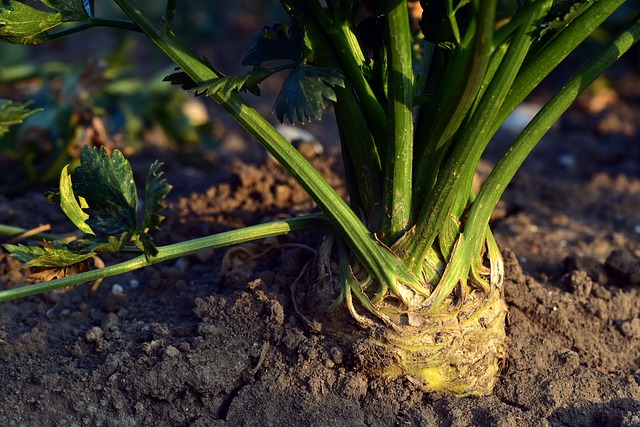
Table: Companion Plants for Red Cabbage Plants
| Good Companion Plants | Bad Companion Plants |
|---|---|
| camomile | broccoli |
| celery | brussels sprouts |
| coriander | cauliflower |
| leek | chinese cabbage |
| onions | kohlrabi |
| peas | leafy cabbage |
| potatoes | mustard |
| spinach | pointed cabbage |
| tomatoes | white cabbage |
Mixed Crop Planting Plans With Red Cabbage: Examples & Ideas
Mixed cultivation brings you many advantages as a gardener. To give you inspiration for your mixed cultivation with red cabbage, we have prepared a few bed plans for you.
Finding the Right Type of Red Cabbage
Even though all varieties prefer the same location and require the same care, there are many varieties that differ in terms of growth, shape and color. Above all, however, the harvest time and weight vary between the different varieties. While early varieties have a shorter vegetation period and therefore usually form smaller heads, late varieties have enough time to form a large, firm head. These large heads are easier to store.
- "Amarant" is an early red cabbage variety. It forms round, medium-sized heads and has a short stalk. (Harvest: mid-June - end of August)
- "Granat" is a fast-growing red cabbage variety and can therefore produce good yields even with a shorter growing season. This variety can be stored. (Harvest: August - end of October)
- "Rodynda" is a late red cabbage variety that can be stored. It has a firm, oval head and a short stalk. The heads are sweet and aromatic and are therefore also suitable for eating raw, e.g. in salads. (Harvest: mid-September - end of October)
So it's best to think about when you want to harvest the red cabbage, whether you prefer smaller or larger heads and what you want to use it for. For a continuous harvest from June to November, you can also combine early and late varieties.

Discover Many Red Cabbage Varieties in Our Library
In our library, you will find information on numerous varieties of red cabbage with cultivation periods, planting and harvesting tips. You will also find companion plants to help you plan a mixed crop.
View Library NowPlanting and Sowing Red Cabbage: In the Garden, Raised Bed or Pot
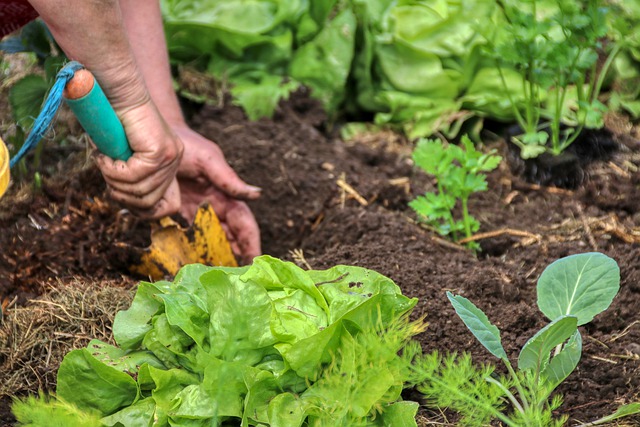
Sowing and Propagating Red Cabbage: It’s That Easy
Red cabbage is usually pre-grown and then planted out. With direct sowing, it is easier for the cabbage to sprout if the growing temperatures are too low, i.e. to form flowers early. You can start propagating red cabbage in January to March. Until the seed has germinated, it needs temperatures of approx. 16 - 20 °C/60 - 68 °C. For the young plants, 12 °C/54 °F is sufficient. However, it should not be colder than this, otherwise the plants will tend to sprout.
Planting Red Cabbage: Spacing and Timing
Depending on the variety, you can then plant the seedlings outdoors between the beginning of April and the end of June . When planting out, there should be a distance of 50 cm/19.7 in between the rows and 40 cm/15.7 in between the plants. Plant the cabbage as deep as possible, but make sure that the growing point is still above the soil. The cotyledons should be just above the soil.
Proper Care and Fertilization of Red Cabbage
As long as the plants are young and small, they can easily be suppressed by weeds. You should therefore regularly mulch the red cabbage with straw, compost or other herbs such as nettles. This also helps to stimulate root growth and promote the water supply. The cabbage always needs enough water and nutrients to form a nice big head. You can add a layer of compost about 2.5 cm/1 in thick once a year as fertilizer. According to Charles Dowding's no-dig method, this is enough fertilizer for the whole season for no-dig beds. "Normal" beds may need a little more compost. You can also mound up the soil around the plant. This will give the cabbage more stability and protect it from pests. If you don't have compost, you can also fertilize with liquid manure at the same intervals. Nettle manure is suitable for cabbage. However, this can attract cabbage white butterflies. As red cabbage is a heavy feeder, you should prepare the soil in the fall and work in some compost.
Preventing Diseases and Pests
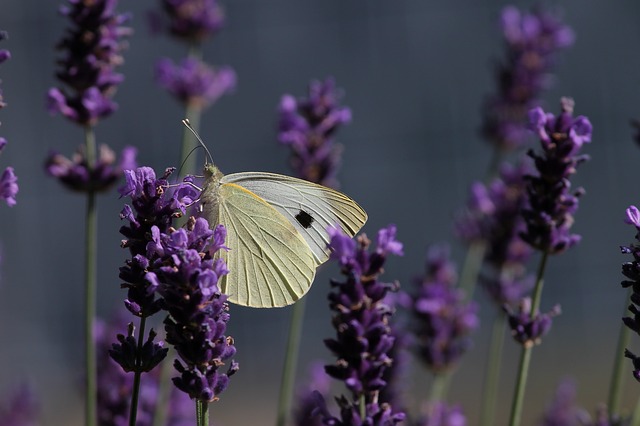
The best way to combat diseases in cabbage is prevention. If the cabbage has sufficient nutrients and an aerated location, it is well equipped. It is also important to remove all harvest residues from the cabbage after harvesting and to leave at least 2 years in between until the next cabbage crop. This will allow the soil to regenerate after the heavy crop. In addition, this prevents "typical" cabbage diseases and pests from taking hold.
Typical Cabbage Diseases at a Glance:
- Black rot: A bacterial disease in which black-brown spots spread across the top of the leaves.
- Downymildew: Causes necrotic spots, the areas look dead and gray. You can find out all about Downy Mildew and How to Combat It here.
- Drought spot: A fungal disease in which dark, brown spots appear on stems and leaves. The infected leaves turn yellow and fall off.
Typical Pests of Cabbage:
- Cabbage white butterfly: This white butterfly lays its eggs at the bottom of the cabbage leaves. When the caterpillars hatch, they feed on the leaves. You can find Tips on Combating Cabbage White Butterflies in this article.
- Cabbage scale insects: Also known as whiteflies, they can cover the underside of leaves with wax and honeydew excrement. However, they are considered to be minor pests.
- Aphids: Cabbage aphids are gray-green and suck sugar and nutrients from the leaves. You can find out How to Control and Prevent Aphids in this article.
Harvest Time: Harvesting and Storing Red Cabbage
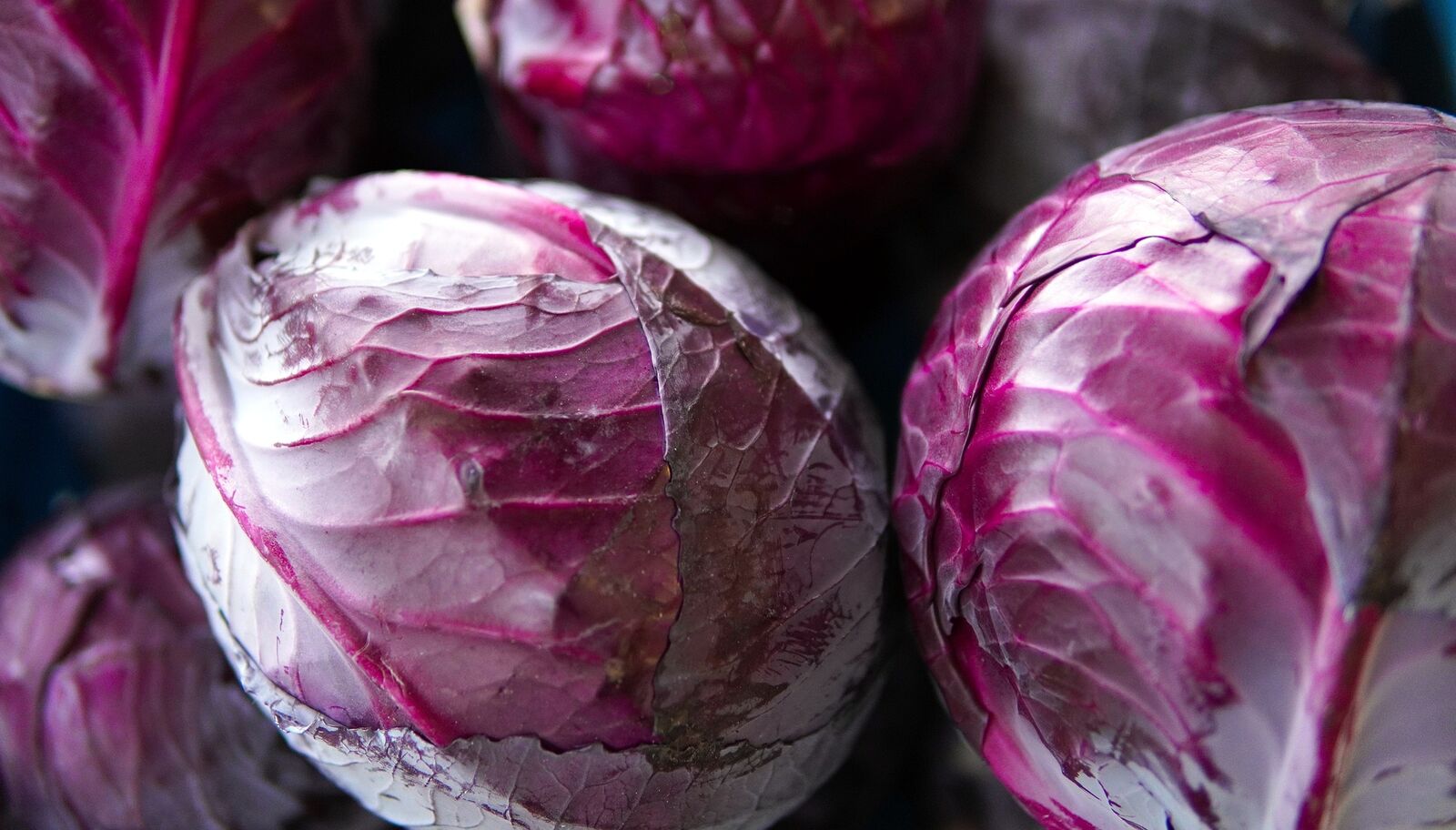
As already mentioned in the section on red cabbage varieties, the best time to harvest the heads depends entirely on the variety and the purpose. With early varieties, harvesting can start as early as mid-July. They tend to produce small, tender heads that taste very good raw and should be processed quickly. Late varieties, on the other hand, are harvested from August to November . As soon as the red cabbage has reached the desired size, remove the outer leaves and cut off the head at the stem.
Harvest Before the First Frost
If you want to store the cabbage, leave it standing for as long as possible. However, it should be harvested before the first few days around 0 °C/32 °F, as it can crack open due to frost. To do this, pull it completely out of the soil and roughly knock the soil off the stalk. If the stalk has been damaged or cut off, it is susceptible to rotting at this point. You can leave the outer leaves on if they are healthy. These protect the cabbage from drying out. Place the cabbage in airy wooden crates and cover them with jute sacks or an old towel. Check the crates regularly for rot or mold. The right storage location is cool and dark.
Processing & Preserving Red Cabbage
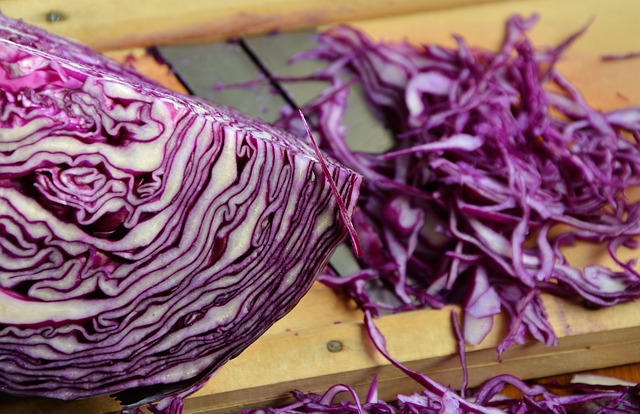
Red cabbage has many uses in the kitchen thanks to its sweet and mild cabbage flavor. It tastes great raw in salads or wraps, for example. Cooked, it is a popular accompaniment to many dishes.
Red Cabbage Recipe to Make Yourself:
- 1 kg/2.2 pd red cabbage
- 50 g/1.8 fl. oz. lard or butter
- 1 onion
- 2 apples
- 1 tbsp sugar
- 2 tbsp vinegar
- ¼ liter/8.75 fl.oz. water
- 4 tbsp red wine
- 2 tsp flour, to thicken
- 1 bay leaf
- 2 cloves
- salt
And This Is How It Works:
Clean and wash the red cabbage first. Then cut the head into quarters and remove the stalk. You can then either slice or finely chop the quarters. Next, dice the onions and apples and sauté them in the fat. As soon as you add the red cabbage, pour the vinegar over it. This will give your red cabbage a nice color. Cover the pan with a lid and leave the cabbage to steam. After 10 minutes, pour in about ¼ liter of water and add some salt and the spices. Then leave to simmer for another 30 - 45 minutes until the red cabbage is soft. You may need to add a little more water in between. When the red cabbage is ready, season it with the red wine. You can also thicken it with flour if you wish.
Red cabbage is a great side dish for roasts, braised meat, game or poultry. But it can of course also be combined very well with other dishes.
We hope you now have everything you need to grow red cabbage yourself. If you have any questions or comments, please write to us at magazin@fryd.app or share your experiences with us on social media. To never miss another article, follow us on Instagram and Facebook or sign up directly for our newsletter.
Want to get helpful gardening tips all year round and plan your own beds in the best possible way? Then register here or download the Fryd app for Android or iOS.
Fryd - Your digital bed planner
Source: Charles Dowding, #No Dig, 2023, Munich: Dorling Kindersley Verlag GmbH
Ann Sophie
Current Topics in the Community

#red , #tuesday

Liked 1 times
#testpostcount

Dec 2025
Popular Articles

Companion Plants for Carrots: What (Not) to Plant With Carrots

Companion Plants for Celery : What (Not) to Plant With Celery?

Strawberry Types: List of Best Strawberry Varieties

Companion Planting With Strawberries: Companion Plants and Planting Plan

Basil Varieties & Types at a Glance

What to Plant With Cabbage: Good and Bad Companion Plants

Fertilizing Strawberries: Home Remedies & Natural Fertilizers at a Glance

Growing Sweet Potatoes: Tips on Cultivation & Companion Plants

Companion Plants for Kitchen Herbs: Chives, Parsley & Co

What Herbs Can Be Planted Together?
FAQ
Depending on the variety (early or late), plant the red cabbage in your raised bed, bed or pot between April and June. Plant your cabbage plant as deep in the soil as possible so that the cotyledons just peek out.
How far apart should I plant red cabbage?
The planting distance for red cabbage is approximately 50 x 50 cm, although there are also small-growing varieties that require less space. The appropriate planting distance for your variety is indicated on the seed packet.
What are companion plants for red cabbage?
Peas, potatoes, leeks, celery, spinach, tomatoes and onions go well alongside red cabbage. Herbs such as coriander and camomile are also a good addition to the vegetable patch with red cabbage.
Why is my red cabbage plant shooting?
Red cabbage forms flowers at temperatures below 12 degrees. Therefore, even with direct sowing, it can quickly happen that the red cabbage starts to shoot. However, you should also ensure that it does not get colder than 12 degrees when planting out young plants.
The harvest time varies depending on the variety: early varieties can be harvested from mid-July, while late varieties ripen between August and November. However, be sure to harvest before the first frosts if you want to store the cabbage undamaged. The head can split open due to frost.